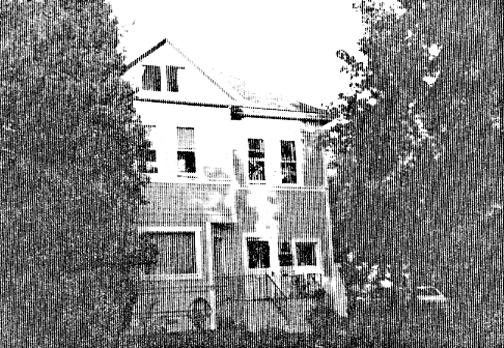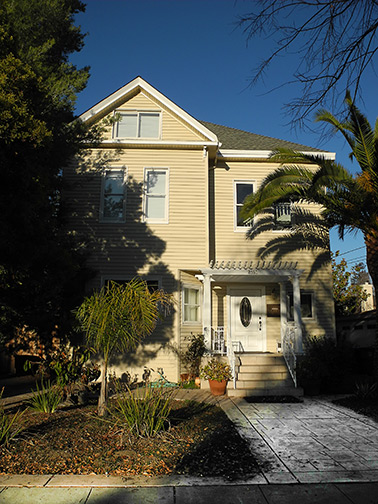 Palo Alto Stanford Heritage
Palo Alto Stanford Heritage |  |
| Inventory photo | Photo taken 2014 |
The following is from the Palo Alto Historic Resources Inventory, 1978, 1984.
The principal decorative motif of this two-story vernacular wood frame structure is a scalloped shingle pattern in the front gable of the squared second-story bay. An unusually large water tank on an elevated tower behind the house was destroyed in the 1906 earthquake. Some interior remodeling was done in 1923, and a garage was added. Later, it was divided into apartments.
A good example of the minimal decoration used to enliven standard vernacular buildings of the era. Alexander Gordon, developer of College Terrace, sold the property in 1893 to Mrs. Delight (also known as Della) H. B. Perry of Santa Cruz County under terms of a trusteeship administered for herself and her three children. She vested full title in her son John Wilbur Perry in 1899. Soon it became the Welakahao Club (eating club) of Stanford students.
Joseph Mesa bought it in 1907 and put in paved sidewalks.
In 1918 it was purchased by Mary Stanton. In 1923 Miss Stanton leased the house to Ray U. Muir, stipulating certain repairs and internal improvements. Muir and his wife Edith owned and operated a Mayfield meat market; for a time they shared space in the house with candy store owner Lionel Lewis. They subsequently purchased and moved to the house at 2131 Hanover.
The house was rented to short-term tenants in the 1930s and 1940s, then acquired by Charles W. Cannon in 1950, who redeveloped its interior for apartment rentals.
The story is told that when one of the Eating Club members ran from the house during the 1906 earthquake, he was knocked from his feet by a flood of water from the fallen water tank: "Tidal wave!" he shouted, and ran for the hills.
David Cooney, trustee, is listed as the owner.
And from the Centennial Buildings Tour, prepared by The City of Palo Alto Historic Resources Board:
Historically known as the "Welakahao Club," a Stanford students' eating club, this is a good example of the minimal decoration used to enliven standard vernacular buildings of the era. It was originally located at 413, then 332, then 551 Hanover. An unusually large water tank on an elevated tower behind the house was destroyed in the 1906 quake.
Entry Map
This house was built in 1893 and is a Category 4 on the Historic Buildings Inventory. The lot measures 50 x 125 feet. Two garages are on the property. The architect and/or builder are unknown.
Sources: Palo Alto City Directories; Book 157 (Deeds), p. 502, 2/15/93; Book 164 (Deeds), p. 388, 10/12/93; Book 206 (Deeds), p. p. 185, 12/31/97; Book 220 (Deeds), p.252–4, 6/9/99; Book 318 (Deeds), p. 262–3, 3/13/07; Book 470 (Deeds), p. 111, 2/23/18; Book 8 (Off. Records). p. 33, 1/20/23; Book 599 (Off Rcords), p. 93, 11/20/31 (Santa Clara Co. Recorder); letter Birge Clark to Gail Woolley 6/12/70; Palo Alto AAUW, ...Gone Tomorrow?; Palo Alto Times, 10/25/07; The Tall Tree, I, No. 6, August 1954 (reprinted in The Tall Tree II, No. 6, April 1986)
E-mail us at either webmaster@pastheritage.org or president@pastheritage.org.
![]() Palo Alto Stanford Heritage—Dedicated to the preservation of Palo Alto's historic buildings.
Palo Alto Stanford Heritage—Dedicated to the preservation of Palo Alto's historic buildings.
Copyright © 2015 Palo Alto Stanford Heritage. All rights reserved.